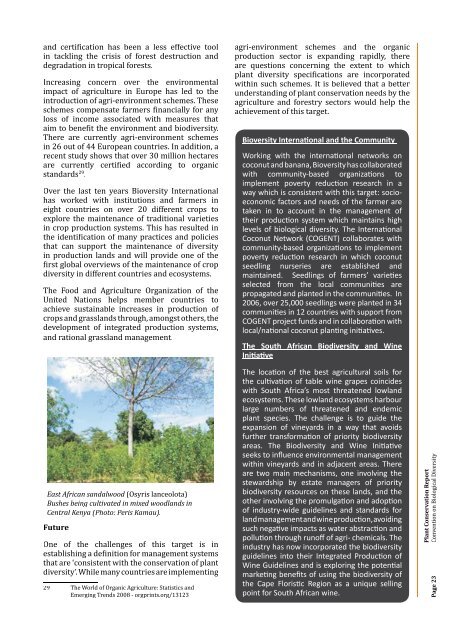from the global partnership for plant conservation
from the global partnership for plant conservation
from the global partnership for plant conservation
Create successful ePaper yourself
Turn your PDF publications into a flip-book with our unique Google optimized e-Paper software.
and certiication has been a less effective toolin tackling <strong>the</strong> crisis of <strong>for</strong>est destruction anddegradation in tropical <strong>for</strong>ests.Increasing concern over <strong>the</strong> environmentalimpact of agriculture in Europe has led to <strong>the</strong>introduction of agri-environment schemes. Theseschemes compensate farmers inancially <strong>for</strong> anyloss of income associated with measures thataim to beneit <strong>the</strong> environment and biodiversity.There are currently agri-environment schemesin 26 out of 44 European countries. In addition, arecent study shows that over 30 million hectaresare currently certiied according to organicstandards 29 .Over <strong>the</strong> last ten years Bioversity Internationalhas worked with institutions and farmers ineight countries on over 20 different crops toexplore <strong>the</strong> maintenance of traditional varietiesin crop production systems. This has resulted in<strong>the</strong> identiication of many practices and policiesthat can support <strong>the</strong> maintenance of diversityin production lands and will provide one of <strong>the</strong>irst <strong>global</strong> overviews of <strong>the</strong> maintenance of cropdiversity in different countries and ecosystems.The Food and Agriculture Organization of <strong>the</strong>United Nations helps member countries toachieve sustainable increases in production ofcrops and grasslands through, amongst o<strong>the</strong>rs, <strong>the</strong>development of integrated production systems,and rational grassland management.agri-environment schemes and <strong>the</strong> organicproduction sector is expanding rapidly, <strong>the</strong>reare questions concerning <strong>the</strong> extent to which<strong>plant</strong> diversity speciications are incorporatedwithin such schemes. It is believed that a betterunderstanding of <strong>plant</strong> <strong>conservation</strong> needs by <strong>the</strong>agriculture and <strong>for</strong>estry sectors would help <strong>the</strong>achievement of this target.Bioversity International and <strong>the</strong> CommunityWorking with <strong>the</strong> international networks oncoconut and banana, Bioversity has collaboratedwith community-based organizations toimplement poverty reduction research in away which is consistent with this target: socioeconomicfactors and needs of <strong>the</strong> farmer aretaken in to account in <strong>the</strong> management of<strong>the</strong>ir production system which maintains highlevels of biological diversity. The InternationalCoconut Network (COGENT) collaborates withcommunity-based organizations to implementpoverty reduction research in which coconutseedling nurseries are established andmaintained. Seedlings of farmers’ varietiesselected <strong>from</strong> <strong>the</strong> local communities arepropagated and <strong>plant</strong>ed in <strong>the</strong> communities. In2006, over 25,000 seedlings were <strong>plant</strong>ed in 34communities in 12 countries with support <strong>from</strong>COGENT project funds and in collaboration withlocal/national coconut <strong>plant</strong>ing initiatives.The South African Biodiversity and WineInitiativeEast African sandalwood (Osyris lanceolota)Bushes being cultivated in mixed woodlands inCentral Kenya (Photo: Peris Kamau).FutureOne of <strong>the</strong> challenges of this target is inestablishing a deinition <strong>for</strong> management systemsthat are ‘consistent with <strong>the</strong> <strong>conservation</strong> of <strong>plant</strong>diversity’. While many countries are implementing29 The World of Organic Agriculture: Statistics andEmerging Trends 2008 - orgprints.org/13123The location of <strong>the</strong> best agricultural soils <strong>for</strong><strong>the</strong> cultivation of table wine grapes coincideswith South Africa’s most threatened lowlandecosystems. These lowland ecosystems harbourlarge numbers of threatened and endemic<strong>plant</strong> species. The challenge is to guide <strong>the</strong>expansion of vineyards in a way that avoidsfur<strong>the</strong>r trans<strong>for</strong>mation of priority biodiversityareas. The Biodiversity and Wine Initiativeseeks to influence environmental managementwithin vineyards and in adjacent areas. Thereare two main mechanisms, one involving <strong>the</strong>stewardship by estate managers of prioritybiodiversity resources on <strong>the</strong>se lands, and <strong>the</strong>o<strong>the</strong>r involving <strong>the</strong> promulgation and adoptionof industry-wide guidelines and standards <strong>for</strong>land management and wine production, avoidingsuch negative impacts as water abstraction andpollution through runoff of agri- chemicals. Theindustry has now incorporated <strong>the</strong> biodiversityguidelines into <strong>the</strong>ir Integrated Production ofWine Guidelines and is exploring <strong>the</strong> potentialmarketing benefits of using <strong>the</strong> biodiversity of<strong>the</strong> Cape Floristic Region as a unique sellingpoint <strong>for</strong> South African wine.Plant Conservation ReportPage 23 Convention on Biological Diversity
















